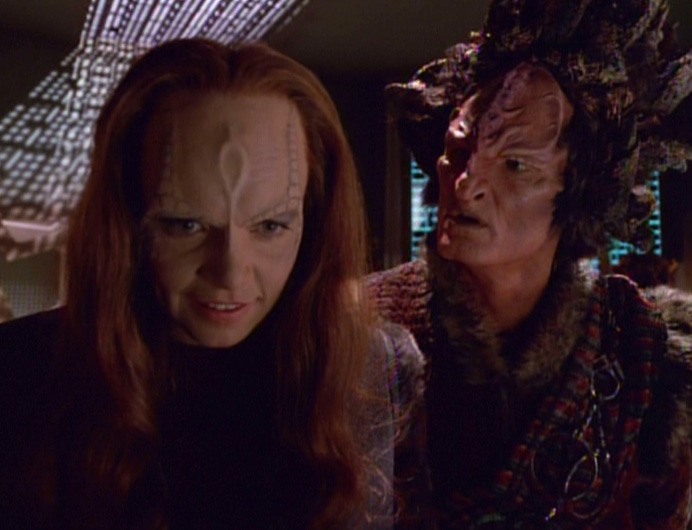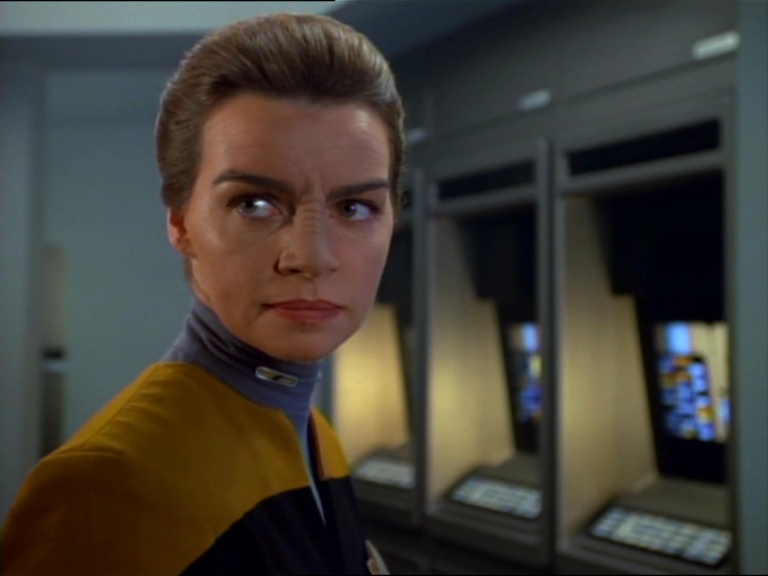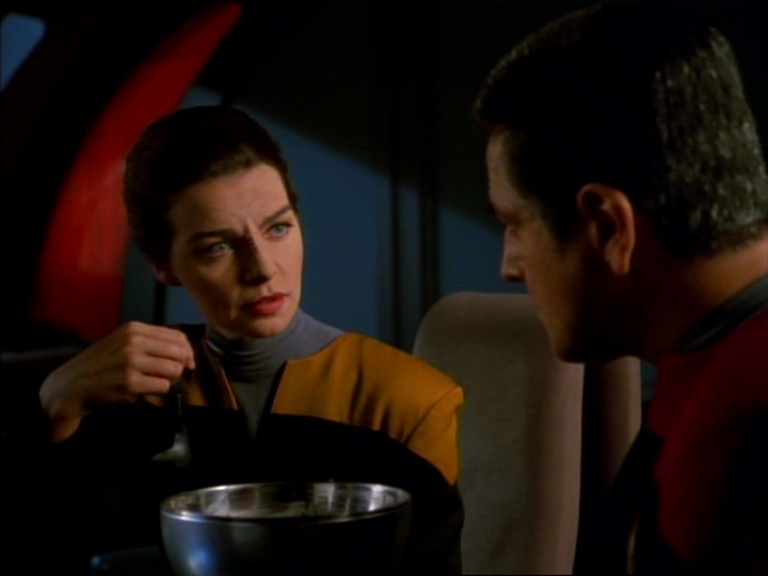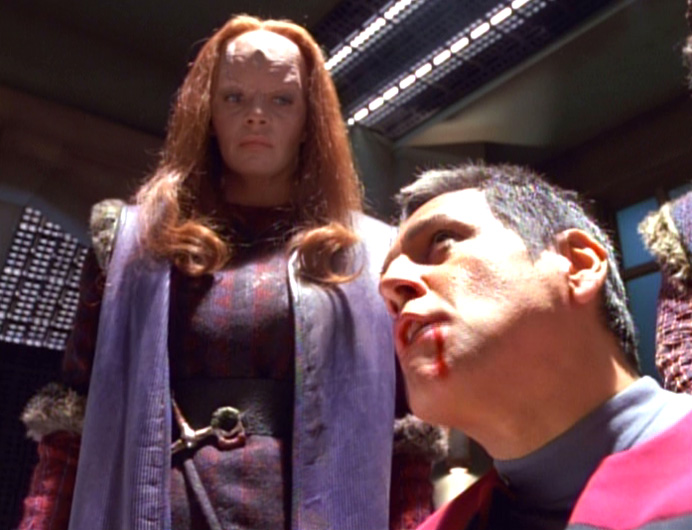
What does a powerful woman who is used to gender equity do when she finds herself in a den of misogyny? She does what women have done for centuries. She negotiates her own form of power.
We first meet Seska on Voyager as a Bajoran crewmember and former member of Chakotay’s crew who is hot-headed and balks at Starfleet protocol. Those traits are not unusual among the former Maquis, but Seska displays a ruthlessness that makes even her Maquis crewmates bristle. In one notable incident, Seska eggs Torres on and encourages her to defy Janeway’s orders to acquire spatial trajector technology (essentially an inter-quadrant transporter) from the Sikarians (VOY: “Prime Factors.”) Seska is established as someone especially defiant of Starfleet principles, and committed to getting what she wants at all costs.

Her open defiance and disdain for Starfleet becomes more understandable when she’s revealed to be an undercover Cardassian agent. Soon after her identity is revealed, she defects to the Kazon because she believes that Voyager should trade Federation technology in exchange for safe passage through their space – something Janeway is unwilling to do. Once with the Kazon, Seska is subjected to misogyny and has her authority repeatedly questioned by Maje Culluh’s subordinates. The Kazon are so misogynistic in fact, that we never see a female member of their species throughout their time on Voyager.
“What is it about the women from your quadrant? You know, she contradicts me in front of the senior askara? My own woman, disputing her Maje in front of others. This is your fault. You’ve let your women get out of control.” – Maje Culluh (VOY: Basics, Part 1)
We know very little about gender roles in Cardassian society. We do know there are more male military officers than female, but women Guls are not unheard of. Most of what we know about Cardassian gender politics comes from the Deep Space Nine episode, “Destiny,” where three Cardassian scientists (all women) work with the Bajoran government on a project to transmit signals through the wormhole. The Cardassian scientist Gilora, remarks to Miles O’Brien, “Men just don’t seem to have a head for this sort of thing. That’s why women dominate the sciences.”
So it would seem then, that women in Cardassian society are stereotyped by their perceived competence as opposed to being seen as inferior to men overall. It may be argued, however, that men hold more power in Cardassian society by virtue of the militaristic nature of their culture, and the fact that there do seem to be more male soldiers than female ones. So Seska may have had some experience deferring to male authority in certain circumstances. Even though the case could be made for a Cardassian patriarchy, it doesn’t seem to match the degree of Kazon society – where women are both unseen and unheard.

Seska, then, grew up in a society that didn’t limit her potential by her gender – even if it might have determined her role in it. She also spent a number of years (possibly even during the Occupation) posing as a Bajoran woman. Bajorans, in contrast to the invading Cardassians, are shown to have a true egalitarian society with no strict gender roles.
What does a woman like Seska do, then, when she finds herself with misogynists for allies? She does what women have done for centuries under those conditions – negotiates power. She ingratiates herself to Maje Culluh, both through her knowledge of Voyager, and through sexual manipulation. As time passes, Culluh starts to listen to her advice more and more, and shuts her down less. Culluh’s men even start to take orders from her without first looking to their Maje to confirm it. His attempts to ‘put her in her place’ become more and more token, and when he seems to be getting out of hand, Seska skillfully pulls him back in through the use of flattery.
In the episode “Maneuvers,” Seska sends a message in Culluh’s name to the other Kazon sects to gather them for an attack against Voyager. Culluh is initially outraged, but Seska talks him down through flattery and deference.
“I am the leader of this sect. You are only a woman.”
“I’m sorry, Culluh.”
“You’ll address me as Maje.”
“Yes. Maje. Please, forgive me.”
“So, how did the other sects respond to my request?”
“They’re on their way to join us.”
“I could do what no one has done since Jal Sankur united the sects to overthrow the Trabe.”
“Yes, Maje.”
“I could have hundreds of ships and thousands of soldiers under my command.”
“Yes, Maje.”
“I could be the most powerful Kazon in the quadrant.”
“Yes, Maje.”
Culluh and Seska, (VOY: Maneuvers)
Culluh shows, then, how misogynists are willing to use the intelligence and skills of a woman, as long as she gains no power and he receives all the credit.
There is no doubt that Seska is a villain. In addition to being a Cardassian agent, she undermines Janeway’s orders, defects to the enemy, essentially rapes Chakotay, and is generally ruthless, vindictive, sexually predatory, and manipulative.

It is interesting then, that behavior that is coded villainous and attributed to such a bad person, has historically been the only way for women to access power under patriarchy. This behavior was considered bad because the idea of women seeking power at all was considered immoral. The femme fatale, the woman who uses her intelligence and sexuality to ingratiate herself and manipulate men, is an enduring trope that is not considered heroic – and is often portrayed as villainous.
In a historical context, a woman ingratiating herself to a powerful man (and sometimes bearing his child) was a way to secure her place in society and therefore her safety and wellbeing. So the idea of the femme fatale and pregnancy as manipulation became villain-coded. There is no doubt that these behaviors, in the context of a more egalitarian society, are predatory and immoral – but no one would argue that the Kazon society is friendly to women.
Seska may have been a terrible person who betrayed and manipulated those around her. But once in the patriarchal society of the Kazon, she used the only tools at her disposal in order to survive.